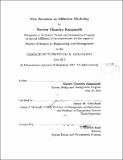| dc.contributor.advisor | James M. Utterback. | en_US |
| dc.contributor.author | Ranganath, Naveen Chandra | en_US |
| dc.contributor.other | Massachusetts Institute of Technology. Engineering Systems Division. | en_US |
| dc.date.accessioned | 2013-07-10T14:52:39Z | |
| dc.date.available | 2013-07-10T14:52:39Z | |
| dc.date.copyright | 2012 | en_US |
| dc.date.issued | 2012 | en_US |
| dc.identifier.uri | http://hdl.handle.net/1721.1/79534 | |
| dc.description | Thesis (S.M.)--Massachusetts Institute of Technology, Engineering Systems Division, 2012. | en_US |
| dc.description | Cataloged from PDF version of thesis. | en_US |
| dc.description | Includes bibliographical references (p. 69-72). | en_US |
| dc.description.abstract | Over the last fifty years, diffusion researchers have sought to explain why the rate of adoption of an innovation varies over time. Some innovations are adopted quickly as compared to others, which take decades for adoption. However, the rate of adoption of an innovation is observed to follow the 'S-curve'. Diffusion modeling is an approach to analyse the process of diffusion of innovation. Several diffusion models have been developed to predict the penetration curves while many other models are developed to explain the complexities of the underlying diffusion process. From the commercial perspective, diffusion modeling is of interest to managers because of its ability to predict sales of a product. Moreover, managers use diffusion models to chalk out strategies for successful product management. This thesis classifies the two diffusion modeling approaches: aggregate and individual. In aggregate modeling approach, the target market is aggregated and analyzed as a whole. Models are developed to forecast sales, analyze the effects of marketing efforts, examine the effects technology interactions, and study cross country diffusion. In individual modeling approach, diffusion is investigated at the consumer-level. The Models incorporate individual preferences in adoption decisions and study various effects of social structure and communication patterns. We analyze these models and discuss its strengths and weaknesses. Beyond this, we identify some of the unconquered problems of multi-product interactions and show the importance of diffusion modeling in this new frontier. | en_US |
| dc.description.statementofresponsibility | by Naveen Chandra Ranganath. | en_US |
| dc.format.extent | 72 p. | en_US |
| dc.language.iso | eng | en_US |
| dc.publisher | Massachusetts Institute of Technology | en_US |
| dc.rights | M.I.T. theses are protected by
copyright. They may be viewed from this source for any purpose, but
reproduction or distribution in any format is prohibited without written
permission. See provided URL for inquiries about permission. | en_US |
| dc.rights.uri | http://dspace.mit.edu/handle/1721.1/7582 | en_US |
| dc.subject | Engineering Systems Division. | en_US |
| dc.title | New frontiers in diffusion modeling | en_US |
| dc.type | Thesis | en_US |
| dc.description.degree | S.M. | en_US |
| dc.contributor.department | Massachusetts Institute of Technology. Engineering Systems Division | |
| dc.identifier.oclc | 849905742 | en_US |
